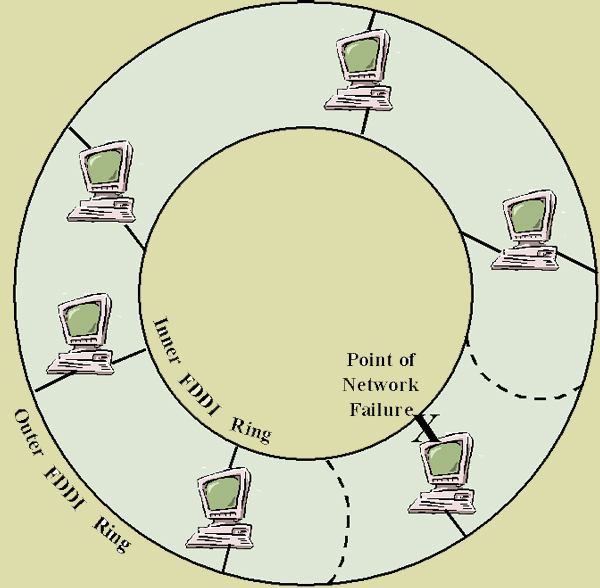
FDDI - Fiber Distributed Data Interface
| Introduction.
FDDI - Fiber Distributed Data Interface
is often used for MANs or larger LANs to connect several buildings in an
office complex. It makes use of a token passing strategy, but its
implementation and topology differ from a Token Ring.
Its basic specifications are given in IEEE 802.5 and some
in 802.8. People have seldom heard of it because it has largely been used for backbones, not access LANs. It has been the network technology of choice for backbone LANs for a number of years, but is now being superseded by ATM and Gigabit Ethernet. As its name implies it runs on fiber optic cabling. It combines high speed performance with the advantages of a token passing ring topology. FDDI runs at 100 Mbps and its topology is a dual ring as shown in the next illustration. |

Since backbones are so important to
the overall function of networks, FDDI was developed to pretty much
guarantee availability. This was done by using dual redundant
fiber optic rings. Each device is connected to both rings having
two implications.
Under normal operating conditions, the secondary ring is idle, passing only enough frames to keep it running. This secondary ring becomes essential when the primary ring fails. Failures are usually caused by a break in the fiber or a faulty NIC. As the following figure illustrates, FDDI isolates the damaged device by wrapping around to the secondary ring and looping back in the other direction thus keeping the ring intact. FDDI also improves over Token Ring in that it allows for multiple frames/packets/tokens to travel over the same network at the same time. This is called shared network technology. A FDDI dual ring supports up to 500 nodes per ring. The total maximum length for each of the cable rings is 100 km or 62.2 miles. Some sort of repeater is needed every two kilometers, which is why it is not considered a WAN network. It is also possible to implement FDDI technology over copper cable in which case it is called CDDI - Copper Distributed Data Interface. Computers on a FDDI network are divided into two classes.
Frame Structure. The FDDI frame structure is similar to the Token Ring, but it uses a timed token protocol. The maximum size of a FDDI frame is 4500 bytes. The FDDI token is a special frame consisting of three octets. A computer that has data to transmit waits for a token frame, takes possession of it, transmits one or more data frames and then releases the token. Some of the major advantages of FDDI are
Some of the major disadvantages
|